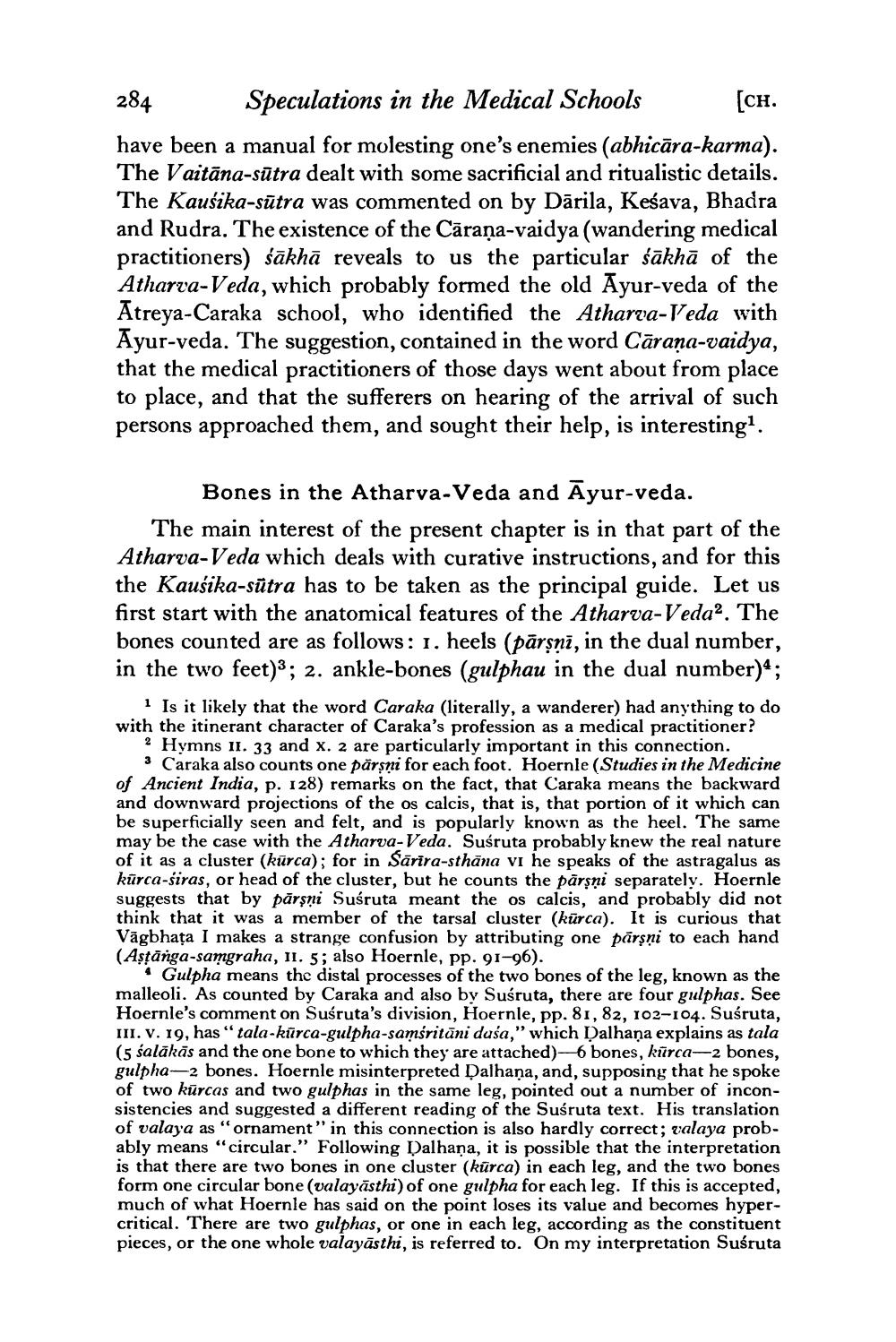________________
284 Speculations in the Medical Schools [ch. have been a manual for molesting one's enemies (abhicāra-karma). The Vaitāna-sūtra dealt with some sacrificial and ritualistic details. The Kausika-sūtra was commented on by Dārila, Keśava, Bhadra and Rudra. The existence of the Cāraṇa-vaidya (wandering medical practitioners) šākhā reveals to us the particular śākhā of the Atharva-Veda, which probably formed the old Ayur-veda of the Atreya-Caraka school, who identified the Atharva-Veda with Ayur-veda. The suggestion, contained in the word Cārana-vaidya, that the medical practitioners of those days went about from place to place, and that the sufferers on hearing of the arrival of such persons approached them, and sought their help, is interesting.
Bones in the Atharva-Veda and Ayur-veda. The main interest of the present chapter is in that part of the Atharva-Veda which deals with curative instructions, and for this the Kausika-sūtra has to be taken as the principal guide. Let us first start with the anatomical features of the Atharva-Veda. The bones counted are as follows: 1. heels (pārşnī, in the dual number, in the two feet): 2. ankle-bones (gulphau in the dual number 4,
1 Is it likely that the word Caraka (literally, a wanderer) had anything to do with the itinerant character of Caraka's profession as a medical practitioner?
2 Hymns II. 33 and x. 2 are particularly important in this connection.
3 Caraka also counts one pārsni for each foot. Hoernle (Studies in the Medicine of Ancient India, p. 128) remarks on the fact, that Caraka means the backward and downward projections of the os calcis, that is, that portion of it which can be superficially seen and felt, and is popularly known as the heel. The same may be the case with the Atharva-Veda. Susruta probably knew the real nature of it as a cluster (kürca); for in Sārira-sthāna vi he speaks of the astragalus as kūrca-siras, or head of the cluster, but he counts the pārsni separately. Hoernle suggests that by pārsni Susruta meant the os calcis, and probably did not think that it was a member of the tarsal cluster (kūrca). It is curious that Vāgbhata I makes a strange confusion by attributing one pārsni to each hand (Astanga-samgraha, II. 5; also Hoernle, pp. 91-96).
* Gulpha means the distal processes of the two bones of the leg, known as the malleoli. As counted by Caraka and also by Susruta, there are four gulphas. See Hoernle's comment on Susruta's division, Hoernle, pp. 81, 82, 102-104. Susruta, III. V. 19, has "tala-kūrca-gulpha-samśritāni duša," which Dalhaņa explains as tala (5 salākās and the one bone to which they are attached)-6 bones, kūrca-2 bones, gulpha-2 bones. Hoernle misinterpreted Dalhaņa, and, supposing that he spoke of two kūrcas and two gulphas in the same leg, pointed out a number of inconsistencies and suggested a different reading of the Susruta text. His translation of valaya as “ornament" in this connection is also hardly correct; valaya probably means "circular." Following Dalhana, it is possible that the interpretation is that there are two bones in one cluster (kūrca) in each leg, and the two bones form one circular bone (valayāsthi) of one gulpha for each leg. If this is accepted, much of what Hoernle has said on the point loses its value and becomes hypercritical. There are two gulphas, or one in each leg, according as the constituent pieces, or the one whole valayāsthi, is referred to. On my interpretation Suśruta




